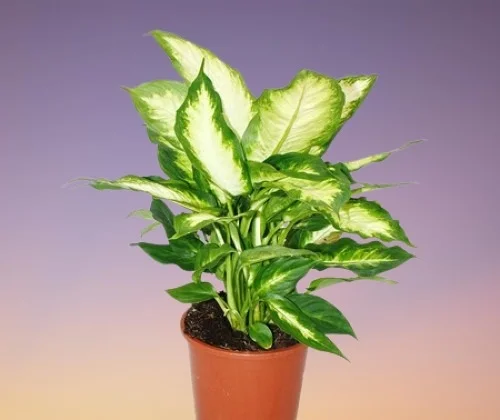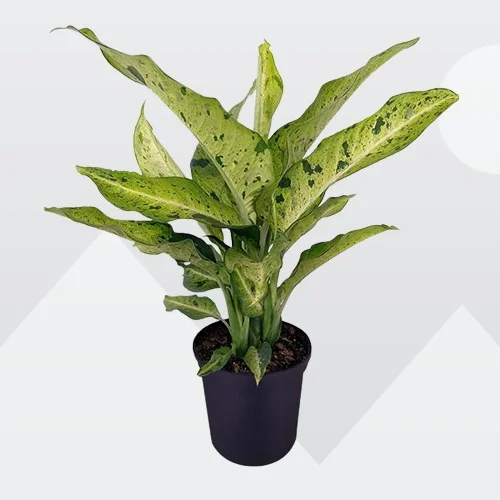Dieffenbachia Common Problems Indoors and their Treatment: Dumb Cane Issues Indoors
Some links in this post may be affiliate links
Dieffenbachia problems indoors are yellow leaves, brown leaves, brown leaf tips, brown leaf spots, leggy growth, pests and diseases among others. Keep reading for more on these problems, their remedies and solutions.
Dieffenbachias commonly called Dumb Canes are popular tropical foliage plants grown for their large, highly decorative leaves, their ease of care and their air cleaning properties.
Dieffenbachias grow best in bright indirect light, warmth of 18-26, humidity of 50-55% and moderately moist, fertile, well-drained potting soils coupled with fortnightly feeding in spring and summer. Learn how to grow and care for Dieffenbachia.
If the correct growing conditions are not provided, Dieffenbachia may develop some problems. We have herebelow outlined for you these problems and how to fix them.

Dieffenbachia Common Issues Indoors & How to Fix Them
1. Yellow leaves
Yellowing leaves on Dieffenbachia is very common but is easy to resolve. The main causes of Dieffenbachia yellow leaves are aging, drafts, inconsistent watering, soggy soil, too little light, temperature stress, nutrients deficiency, salts buildup or being pot-bound.
How to fix it
Aging: This is a natural phenomenon where the older lower Dieffenbachia leaves will turn yellow and die to allow the plant to grow new leaves. Remove the yellow leaves to maintain the plant neat and tidy.
Drafts: Keep the plant away from sources of drafts like windy doors and windows, AC units, heat sources, stoves, hot air vents among others to maintain a warmth of 18-280C.
Inconsistent watering: Water the plant when the top 1-2 inches of soil to dry out but do not allow the soil to dry out completely.
Soggy soil: Ensure that the pot has a drainage hole and the soil is well-draining.
Too little light: Move the plant to a brighter spot where it will receive bright indirect light or instal a grow light if you do not have adequate natural lighting in your home.
Temperature stress: Keep the plant away from sources of drafts like drafty windows, windy doors, AC units, hot air sources among others.
Nutrients deficiency: Feed your Dieffenbachia with a balanced, water-soluble fertilizer every 2-3 weeks in spring and summer. Make sure to follow the instructions on the label of the plant food.
Salts buildup: Regularly flush out excess salts by running a stream of water through the soil until it comes out through the drainage holes and repeat the process several times.
Being pot-bound: Check the bottom of the pot for roots growing through the drainage hole. Repot the plant into a pot one size larger than the current one to provide adequate room for growth. Check out these pots with drainage holes on Amazon.

2. Brown leaves
Some of the causes of brown leaves on Dieffenbachia are inconsistent watering, soggy soil temperature stress, dry air or salts buildup.
How to fix it
Inconsistent watering: Do not water on a schedule. Water when the top 1-2 inches of soil feel dry to the touch.
Soggy soil: Use a pot with a drainage hole and well-draining soil.
Temperature stress: Keep the plant away from sources of drafts like AC units, windy doors, heat sources, hot air vents among others.
Dry air: Set the pot on a wet pebble tray, use a cool mist humidifier or group the plants together to elevate humidity.
Salts buildup: Avoid too much fertilizer and do not feed in fall and winter. Flush out excess chemicals from the soil.
3. Brown leaf tips
Dieffenbachia brown leaf tips are caused by too dry air, underwatering, salts buildup or cold drafts.
How to fix it
Trim off the brown tips with sterilized scissors and ensure to maintain the normal leaf shape.
Dry air: To increase humidity, set the pot on a wet pebble tray, use a cool mist humidifier, group the plants together or grow the plant in a well-lit bathroom, kitchen, laundry area and other moist areas in the home.
Underwatering:Keep the soil consistently moist in spring and summer. Cut down on watering in fall and winter and never allow the soil to dry out completely.
Salts buildup: Leach out accumulated salts by running a stream of water through the soil until it comes out through the drainage hole. Let the water run for 5-10 minutes to get rid of as much salt as possible.
Cold drafts: Protect the plant from cold drafts (cold air) to maintain a warmth of 18-280C with a minimum of 150C.

4. Leggy growth
Leggy growth on Dieffenbachia is caused by insufficient light, nutrients deficiency or aging.
How to fix it
Cutback the leggy stems to rejuvenate new growth and encourage a bushy, compact growth.
Insufficient light: Move the plant to a brighter spot where it will receive bright indirect light or use a grow light if the natural lighting is not adequate.
Nutrients deficiency: Feed the plant with a balanced, water-soluble fertilizer every 2-3 weeks in spring and summer.
Aging: As the plant ages, naturally the stems become bare and straggly.
5. Brown leaf spots
Brown leaf spots on Dieffenbachia are caused by soggy soil, drafts, direct sunlight or leaf spot disease.
How to fix it
Isolate the affected plant, cut away the affected parts and discard them.
Soggy soil: Use free-draining soil and a pot that has a drainage hole.
Drafts: Keep the plant away from drafts emanating from AC units, hot air vents, heat sources, windy doors and windows among others.
Direct sunlight: Move the plant away from direct sunlight or use a light curtain to filter the sunshine.
Leaf spot disease: which is prevalent in warm, damp, stuffy conditions. Look out for brown, moist spots on the foliage which may enlarge, merge and kill the whole leaf. See below under 'diseases' on how to control the disease.

6. Diseases
Dieffenbachia is prone to three diseases which if not attended to properly may lead to the death and loss of the plant.
(a) Leaf spot disease which is characterized by brown, moist spots on the foliage. In a serious attack the spots can enlarge and merge, killing the whole leaf.
How to fix it
- Remove and burn the affected parts of the plant to reduce the risk of spread to the rest of the plants.
- Spray the affected plant with a systemic fungicide and ensure that all the parts are completely covered with the fungicidal solution.
- Keep the plant on the dry side and do not mist it.
- Maintain good air flow to discourage the disease.
- Water from the bottom to avoid wetting the leaves.
- Use a pot with a drainage hole and a well-draining soil to avoid sogginess.
(b) Root-rot disease which is a fungal disease prevelant in soggy soil. It is characterized by yellowing and wilting of the leaves which is rapidly followed by browning and plant collapse.
How to fix it
- Carefully, slip the plant out of its pot and inspect the roots. Brown mushy roots indicate root-rot.
- Cut the brown-black roots and treat the healthy roots with a copper-based fungicidal solution as recommended by the manufacturer.
- Repot the plant in fresh, well-draining soil and keep it dry for some time before resuming watering.
- Ensure that the pot has a drainage hole to prevent the soil from getting soggy.
- Reduce watering in fall and winter as growth is minimal at this time, therefore, the plant does not need much water.
(c) Stem-rot disease which is characterized by part of the stem turning soft and rotten. It is a fungal disease prevelant in wet, cool and poorly ventilated growing conditions which spreads rapidly and kills the plant.
How to fix it
- If caught early, the disease can be treated but if it has spread, the plant cannot be saved and it should be discarded.
- To save a plant that is in the early stages of infestation, cut away and discard or burn the diseased tissue.
- Spray the entire plant with a copper-based fungicidal solution as indicated by the manufacturer.
- Keep the soil on the drier side; use free-draining soil and a pot with a drainage hole.
- Maintain good air flow and keep the plant in warm conditions.
Note:If the plant is too far gone, discard or burn it. Discard its pot and the soil as the treatment is not effective and may spread to the rest of the plants.

7. Pests
Common pests on Dieffenbachia are scale insects, mealybugs and spidermites.
How to fix it
- Isolate the affected plant to prevent spread to other plants.
- Treat the plant with an insecticidal soap or neem oil as per the manufacturer's recommendations.
- Regularly check underneath and between the leaves for these pests and carry out timely control measures.
- Maintain the plant well pruned and elevate humidity to minimize the pest infestations.
8. Loss of leaf color or variegation
Exposing Dieffenbachia to direct sunlight or excessive brightness will lead to loss of leaf color.
How to fix it
Move the plant to a more shaded spot or shield it from direct sunlight by installing a light curtain.
9. Toxicity
Dieffenbachia are toxic to both humans and pets as indicated by the ASPCA. If ingested, they may cause temporary swelling of the tongue and the throat which may lead to a temporary loss of speech and hence the common name dumb cane. In severe cases suffocation may occur.
How to fix it
Keep the plant away from the reach of children and pets to avoid any mishaps.
Always use hand gloves and wash your hands thoroughly after handling this plant.
You liked it? Share on social media.
Related Content
Amazon Associates Disclosure
Homeplantsguide.com is a participant in the Amazon Services LLC Associates Program, an affiliate advertising program designed to provide a means for sites to earn advertising fees by advertising and linking to amazon.com.


